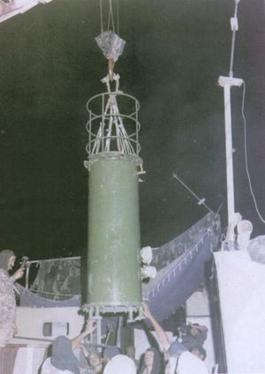
Back عملية بوخران الثانية Arabic पोखरण-2 Bihari পোখরান-২ Bengali/Bangla Operaatio Shakti Finnish Pokhran-II French पोखरण-2 Hindi インドの核実験 (1998年) Japanese 포카란 2차 핵 실험 Korean ഓപ്പറേഷൻ ശക്തി Malayalam पोखरण २ Marathi
| Pokhran-II Operation Shakti | |
|---|---|
 A cylindrical shaped nuclear bomb, Shakti I, prior to its detonation. | |
| Information | |
| Country | India |
| Test site | Pokhran Test Range, Rajasthan |
| Coordinates | 27°04′44″N 71°43′20″E / 27.07889°N 71.72222°E |
| Period | 11–13 May 1998[2] |
| Number of tests | 3 (5 devices fired) |
| Test type | Underground tests (underground, underground shaft) |
| Device type | Fission and Fusion |
| Max. yield | 45 kilotons of TNT (190 TJ) tested;[1]
Scale down of 200 kt model |
| Test chronology | |
| ||
|---|---|---|
|
Legislations
Treaties and accords
Missions and agencies
Controversies
Wars and attacks
Gallery: Picture, Sound, Video |
||
The Pokhran-II tests were a series of five nuclear bomb test explosions conducted by India at the Indian Army's Pokhran Test Range in May 1998.[3] It was the second instance of nuclear testing conducted by India; the first test, code-named Smiling Buddha, was conducted in May 1974.[4]
The tests achieved their main objective of giving India the capability to build fission and thermonuclear weapons with yields up to 200 kilotons.[1] The then-Chairman of the Indian Atomic Energy Commission described each one of the explosions of Pokhran-II to be "equivalent to several tests carried out by other nuclear weapon states over decades".[5] Subsequently, India established computer simulation capability to predict the yields of nuclear explosives whose designs are related to the designs of explosives used in this test.[1]
Pokhran-II consisted of five detonations, the first of which was a fusion bomb while the remaining four were fission bombs.[3] The tests were initiated on 11 May 1998, under the assigned code name Operation Shakti, with the detonation of one fusion and two fission bombs.[3] On 13 May 1998, two additional fission devices were detonated,[6] and the Indian government led by Prime Minister Atal Bihari Vajpayee shortly convened a press conference to declare India as a full-fledged nuclear state.[6] The tests resulted in a variety of sanctions against India by a number of major countries including Japan and the United States.
Many names have been assigned to these tests; originally these were collectively called Operation Shakti–98, and the five nuclear bombs were designated Shakti-I through to Shakti-V. More recently, the operation as a whole has come to be known as Pokhran-II, and the 1974 explosion as Pokhran-I.[7]
- ^ a b c Cite error: The named reference
:0was invoked but never defined (see the help page). - ^ Ganguly, Sumit (1999). "India's Pathway to Pokhran II: The Prospects and Sources of New Delhi's Nuclear Weapons Program". International Security. 23 (4): 148–177. doi:10.1162/isec.23.4.148. ISSN 0162-2889. JSTOR 2539297. S2CID 57565560.
- ^ a b c CNN India Bureau (17 May 1998). "India releases pictures of nuclear tests". CNN India Bureau. CNN India Bureau. Retrieved 14 June 2015.
{{cite news}}:|last1=has generic name (help) - ^ "Official press release by India". meadev.gov.in/. Ministry of External Affairs, 1998. Retrieved 14 June 2015.
- ^ "We have an adequate scientific database for designing ... a credible nuclear deterrent". Frontline. 16. 2–15 January 1999. Archived from the original on 28 October 2019.
- ^ a b Cite error: The named reference
Nuclear politicswas invoked but never defined (see the help page). - ^ "Why May 11 be celebrated as National Technology Day? Things you should know". Times of India. 11 May 2020.
© MMXXIII Rich X Search. We shall prevail. All rights reserved. Rich X Search

